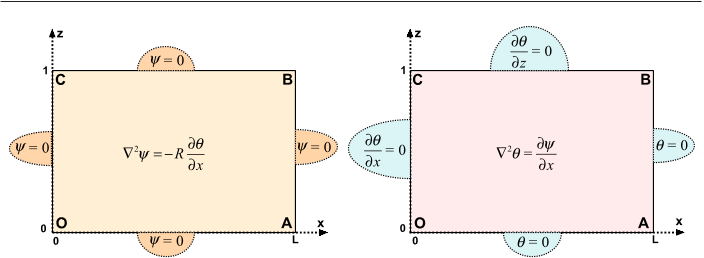




Did you find this useful? Give us your feedback











2 citations
1 citations
1 citations
1 citations
...Tyvand et al. (2019) designed and solved numerically a two-dimensional (2D) problem in a rectangle of the HRL type which is fully non-degenerate, which means that the onset is governed by a non-normal-mode solution where the horizontal and vertical dependencies cannot be separated from one another....
[...]
...Little is still known on non-separable eigenfunctions of non-normal mode type (Tyvand and Nøland 2019; Tyvand et al. 2019)....
[...]
42 citations
...The details of Wooding’s theory were carried out by Beck (1972) and Zebib (1978), for rectangular and circular cylinders, respectively....
[...]
27 citations
...The only known case where the present configuration of a porous rectangular box is known to give a advected wave solution at marginal stability, was investigated by Rees and Tyvand (2004a)....
[...]
...Rees and Tyvand (2004b) showed that the streamlines and isotherms could have been interchanged for the present problem, if there had been a normal-mode solution in the vertical direction, because of a degeneracy in that eigenvalue problem....
[...]
...…the case with known solutions for the onset of convection in 2D rectangular boxes, but there is one exception: The rectangular box studied by Rees and Tyvand (2004a) shows a one-way wave with continuously varying wavelength being repeatedly generated at x = 0 to be advected out of the…...
[...]
...3.1.2 Local Flow Near (L, 0) The local behavior of the eigenfunctions near the second corner A (with coordinates (L, 0)) can be deduced fromNilsen and Storesletten (1990), see also Rees and Tyvand (2004b)....
[...]
...Rees and Tyvand (2004b) showed that this quarter of a wavelength displacement between internal cell walls for flow and cell walls for temperature holds for a class of 2D enclosures, with arbitrary contours that are impermeable and have zero perturbation temperature....
[...]
25 citations
...A non-normal-mode solution for a full 3D problem was given by Haugen and Tyvand (2003), for a circular cylinder with conducting walls....
[...]
23 citations
...Storesletten and Tveitereid (1991) investigated a problem where the range of validity of this assumption of 2D flow has been scrutinized....
[...]
23 citations
...Wang (1998, 1999) exemplified how the cases solved by Nield (1968) can be adjusted to be valid for cylinders with normal-mode-compatible wall conditions....
[...]
Yet the preferred cell with minimum Rayleigh number is always expected to be one single flow cell, and with one dominating thermal cell, with an additional smaller and weaker thermal cell on the right hand side.
The Neumann type of impermeable/insulating conditions (Wooding 1959) and Dirichlet type of conducting walls that are open to inflow/outflow.
Since the biharmonic operator does not separate in orthogonal coordinate systems, there is no general closed-form analytical eigenfunction available, even for a rectangular geometry.
With normal modes valid over the horizontal cylinder cross-section, there is no need for normal modes in the third (vertical) direction in order to derive analytical eigenfunctions.
The assumption of 2D flow in the x, z plane isvalid also for a 3D porous medium with thickness b in the y direction, if two constraints are met: (i) The thermomechanical wall conditions at y = 0 and y = b are those of impermeable and thermally insulating walls.
Inserting the time dependency of a single oscillatory frequency changes the wave equation to a Helmholtz eigenvalue equation for the free vibrations, with the wave number as the eigenvalue.
The only modification to be made is the transformation of the local coordinates z → (z − 1), resulting in the formulaψ ∼ x(z − 1) +O(x3(z − 1)) +O(x(z − 1)3), (46)valid for the local streamfunction around the corner C.
This behavior occurs because of the mutual asymmetry between the thermomechanical conditions at x = 0 and those at x = L.A general tendency in all the Figures 2-4 is a higher concentration of streamlines than of isotherms near the right-hand side AB of the rectangle.